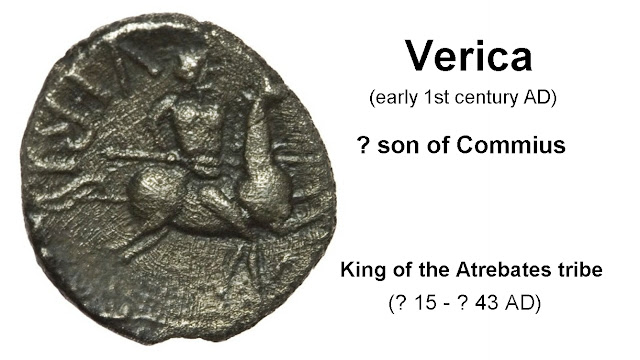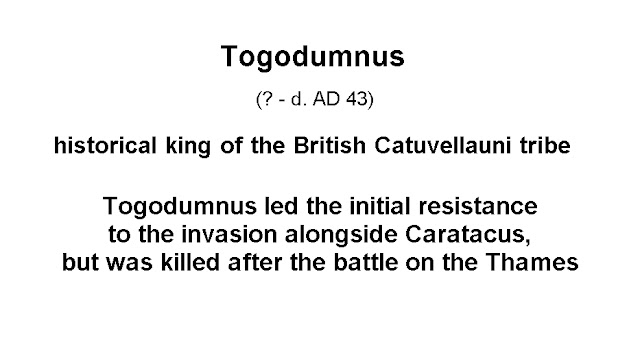The Roman conquest of Britain was a gradual process, beginning effectively in A.D. 43 under Emperor Claudius, whose general Aulus Plautius served as first governor of Roman Britain.
Britain had enjoyed diplomatic and trading links with the Romans
since Julius Caesar's expeditions in 55 and 54 B.C., and Roman economic and cultural influence was a significant part of the British late pre-Roman Iron Age, especially in the south.
Augustus prepared invasions in 34 B.C., 27 B.C. and 25 B.C. The first and third were called off due to revolts elsewhere in the empire, the second because the Britons seemed ready to come to terms. According to Strabo's Geography, written during this period, says Britain paid more in customs and duties than could be raised by taxation if the island were conquered.
By the 40s A.D., the political situation within Britain was apparently in ferment. The Catuvellauni had displaced the Trinovantes as the most powerful kingdom in south-eastern Britain, taking over the former Trinovantian capital of Camulodunum, and were pressing their neighbours the Atrebates, ruled by the descendants of Julius Caesar's former ally Commius.
In 43 Claudius mounted an invasion force to re-instate Verica, an exiled king of the Atrebates. Aulus Plautius, a distinguished senator, was given overall charge of four legions, totalling about 20,000 men, plus about the same number of auxiliaries.
The main invasion force under Aulus Plautius crossed in three divisions. The port of departure is usually taken to have been Boulogne, and the main landing at Richborough. Neither of these locations is certain.
British resistance was led by Togodumnus and Caratacus, sons of the late king of the Catuvellauni, Cunobeline. A substantial British
force met the Romans at a river crossing thought to be near Rochester on the River Medway. The battle raged for two days. Hosidius Geta was almost captured, but recovered and turned the battle so decisively that he was awarded the "Roman triumph".
The British were pushed back to the Thames. They were pursued by the Romans across the river causing some Roman losses in the marshes of Essex. Whether the Romans made use of an existing bridge for this purpose or built a temporary one is uncertain.
Togodumnus died shortly after the battle on the Thames. Plautius halted and sent word for Claudius to join him for the final push. Cassius Dio presents this as Plautius needing the emperor's
assistance to defeat the resurgent British, who were determined to avenge Togodumnus. However, Claudius was no military man. Claudius's arch says he received the surrender of eleven kings without any loss. Cassius Dio relates that he brought war elephants and heavy armaments which would have overawed any remaining native resistance. The Romans established their new capital at Camulodunum and Claudius returned to Rome to celebrate his victory. Caratacus escaped and would continue the resistance further west.
Vespasian took a force westwards subduing tribes and capturing oppida as he went, going at least as far as Exeter. In the north, within four years of the invasion it is likely that an area south of a line from the Humber to the Severn Estuary was under Roman control.
Late in 47 the new governor of Britain, Publius Ostorius Scapula, began a campaign against the tribes of modern-day Wales, and the Cheshire Gap. The Silures of southeast Wales caused considerable problems to Ostorius and fiercely defended the Welsh border country. Caratacus himself was defeated in the Battle of Caer Caradoc and fled to the Roman client tribe of the Brigantes who occupied the Pennines.
When Nero became emperor in 54, he seems to have decided to continue the invasion. Gaius Suetonius Paulinus mounted a successful campaign across Wales, famously destroying the druidical centre at Mona or Anglesey in 60 at what historians later
called the Menai Massacre. Final occupation of Wales was postponed however when the rebellion of Boudica forced the Romans to return to the south east. The Silures were not finally conquered until circa 76 when Sextus Julius Frontinus' long campaign against them began to have success.
Following the successful suppression of Boudica's uprising, a number of new Roman governors continued the conquest by edging north.
Arriving in mid-summer of 78, Agricola found several previously defeated peoples had re-established their independence. The first to be dealt with were the Ordovices of north Wales, who had destroyed a cavalry ala of Roman auxiliaries stationed in their territory. Knowing the terrain from his prior military service in
Britain, he was able to move quickly to defeat and virtually exterminate them. He then invaded Anglesey, forcing the inhabitants to sue for peace. The following year he moved against the Brigantes of northern England and the Selgovae along the southern coast of Scotland, using overwhelming military power to re-establish Roman control.
Tacitus says that after a combination of force and diplomacy quieted discontent among the Britons who had been conquered previously, Agricola built forts in their territories in 79. In 80 he marched to the Firth of Tay, not returning south until 81, at which time he consolidated his gains in the new lands that he had conquered, and in the rebellious lands that he had re-conquered. In 82 he sailed to either Kintyre or the shores of Argyll, or to both. In
83 and 84 he moved north along Scotland's eastern and northern coasts using both land and naval forces, campaigning successfully against the inhabitants, and winning a significant victory over the northern British peoples led by Calgacus at the Battle of Mons Graupius.
Prior to his recall in 84, Agricola built a network of military roads and forts to secure the Roman occupation. Existing forts were strengthened and new ones planted in northeastern Scotland along the Highland Line, consolidating control of the glens that provided access to and from the Scottish Highlands. In southern-most Caledonia, the lands of the Selgovae, approximating to modern Dumfriesshire and the Stewartry of Kirkcudbright, were heavily planted with forts, not only establishing effective control there, but also completing a military enclosure of south-central Scotland. In contrast to Roman actions against the Selgovae, the territories of the Novantae, Damnonii, and Votadini were not planted with forts, and there is nothing to indicate that the Romans were at war with them.
Agricola was recalled to Rome by Domitian. His successors are not named in any surviving source, but it seems they were unable or unwilling to further subdue the far north. Fortifications of the Gask Ridge in Perthshire, erected to consolidate the Roman presence in Scotland in the aftermath of Mons Graupius, were abandoned within the space of a few years. It is equally likely that the costs of a drawn-out war outweighed any economic or political benefit and it was more profitable to leave the Caledonians alone and only under de jure submission.
Roman occupation was withdrawn to a line subsequently established by the construction of Hadrian's Wall. An attempt was made to push this line north to the River Clyde-River Forth area in 142 when the Antonine Wall was constructed. This was once again abandoned after two decades and only subsequently re-occupied on an occasional basis.




















